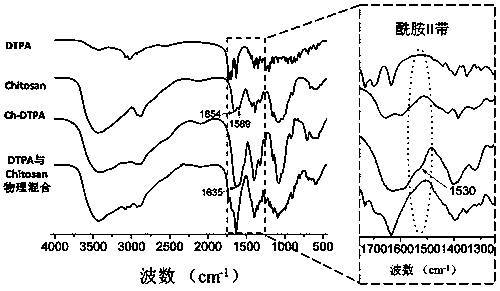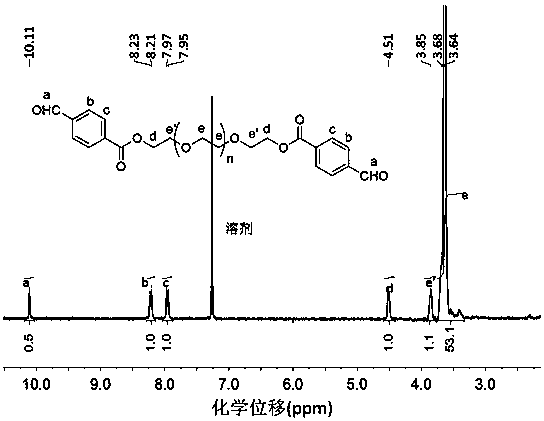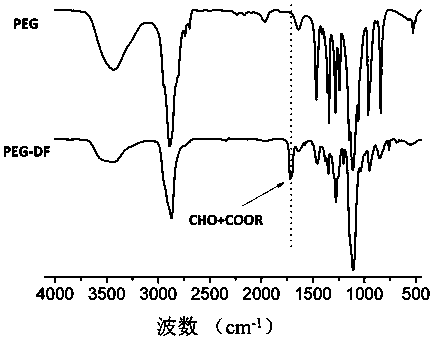A kind of nuclear magnetic resonance visualization injectable pH-sensitive self-healing hydrogel and its preparation method and application
A nuclear magnetic resonance and hydrogel technology, which is applied in the fields of chemistry and biomedicine, can solve the problem that the gel cannot be developed, and achieve the effect of reducing the risk of lesions and less trauma.
- Summary
- Abstract
- Description
- Claims
- Application Information
AI Technical Summary
Problems solved by technology
Method used
Image
Examples
Embodiment 1
[0043] Preparation of Ch-DTPA
[0044] 1 g of chitosan (Chitosan) was heated to 65° C. with 70 mL of 50 mM dilute hydrochloric acid and stirred for 3 h to dissolve completely. DTPA (0.9102g, 2.3mmol) was dissolved in a small amount of secondary water, and the pH was adjusted to 4.7 with TEMED. NHS (0.3199g, 2.8mmol), EDC (0.5328g, 2.8mmol) were dissolved in 50mM dilute hydrochloric acid solution, mixed with DTPA solution at 0°C and added dropwise to Chitosan solution. Stir the reaction in an oil bath at 75°C for 30h, and continue to stir at room temperature for 12h. After the reaction stopped, put it into a dialysis bag with a molecular weight cut-off of 8k-14k, and use secondary water as the medium for dialysis for 3 days. The dialyzed inner fluid was freeze-dried to obtain Ch-DTPA as light yellow powder. The compound was characterized by FT-IR.
[0045] DTPA, Chitosan, Ch-DTPA and the mixture of DTPA and Chitosan were tested by FT-IR. Depend on figure 1 It can be seen ...
Embodiment 2
[0051] Preparation of Ch-DTPA
[0052] 1 g of chitosan (Chitosan) was heated to 65° C. with 70 mL of 50 mM dilute hydrochloric acid and stirred for 3 h to dissolve completely. DTPA (0.9102g, 2.3mmol) was dissolved in a small amount of secondary water, and the pH was adjusted to 4.7 with TEMED. NHS (0.3199g, 2.8mmol), EDC (0.5328g, 2.8mmol) were dissolved in 50mM dilute hydrochloric acid solution, mixed with DTPA solution at 0°C and added dropwise to Chitosan solution. Stir the reaction in an oil bath at 75°C for 30h, and continue to stir at room temperature for 12h. After the reaction stopped, put it into a dialysis bag with a molecular weight cut-off of 8k-14k, and use secondary water as the medium for dialysis for 3 days. The dialyzed inner fluid was freeze-dried to obtain Ch-DTPA as light yellow powder.
[0053] PEG 1k - Preparation of DF
[0054] Polyethylene glycol PEG 1000 (10.00g, 10.0mmol) was dried overnight in a vacuum oven at 50°C and dissolved in 100mL of dry ...
Embodiment 3
[0058] Preparation of Ch-DTPA
[0059] 1g chitosan Chitosan was heated to 65°C with 70mL 50mM dilute hydrochloric acid and stirred for 3h to dissolve completely. DTPA (1.21 g, 3.1 mmol) was dissolved in a small amount of secondary water, and the pH was adjusted to 4.7 with N,N,N',N'-tetramethylethylenediamine TEMED. N-hydroxysuccinimide NHS (0.43g, 3.72mmol), EDC (0.7131g, 3.72mmol) was dissolved in 50mM dilute hydrochloric acid solution, mixed with DTPA solution at 0°C and added dropwise to Chitosan solution. Stir the reaction in an oil bath at 75°C for 30h, and continue to stir at room temperature for 12h. After the reaction stopped, put it into a dialysis bag with a molecular weight cut-off of 8k-14k, and use secondary water as the medium for dialysis for 3 days. The dialyzed inner fluid was freeze-dried to obtain Ch-DTPA as light yellow powder. The compound was characterized by FT-IR. PEG 4K - Preparation of DA
[0060] Polyethylene glycol PEG 4000, acetic anhydride ...
PUM
 Login to View More
Login to View More Abstract
Description
Claims
Application Information
 Login to View More
Login to View More - R&D Engineer
- R&D Manager
- IP Professional
- Industry Leading Data Capabilities
- Powerful AI technology
- Patent DNA Extraction
Browse by: Latest US Patents, China's latest patents, Technical Efficacy Thesaurus, Application Domain, Technology Topic, Popular Technical Reports.
© 2024 PatSnap. All rights reserved.Legal|Privacy policy|Modern Slavery Act Transparency Statement|Sitemap|About US| Contact US: help@patsnap.com










